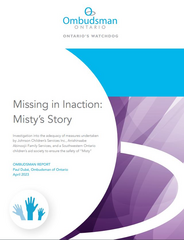Multiple child welfare organizations failed to ensure the safety of a vulnerable Indigenous girl who repeatedly went missing while she was supposed to be receiving supervised services from a foster care agency, Ontario Ombudsman Paul Dubé’s latest investigation has found.
In his report, Missing in Inaction, Misty’s Story, released on 13 April 2023, the Ombudsman examines what went wrong during the 47 days in 2020 that “Misty,” a 13-year-old from Northern Ontario, was living in a home operated by Johnson Children’s Services.
Misty, who has unique vulnerabilities, a history of substance abuse and was a suspected victim of sex trafficking, went missing seven times while she was in Johnson’s care in a Southwestern Ontario city (which is not identified in the report in order to protect her identity). At one point, she disappeared for 19 days. During these absences, there is evidence she was physically and sexually assaulted, used hard drugs, and suffered an overdose.
The Ombudsman launched his investigation after concerns were raised about the adequacy of measures taken to ensure Misty’s safety by Johnson, as well as Anishinaabe Abinooji Family Services (AAFS), an Indigenous children’s aid society near her home community, and the children’s aid society in the city where she went missing, called the “Southwestern CAS” in the report.
AAFS placed Misty with Johnson when it was unable to find resources near her home community in Northern Ontario that met her complex needs. Although Johnson had a chequered history of failing to comply with provincial regulations, AAFS considered itself out of options, the investigation found.
“It is a sad and longstanding reality that Northern Ontario lacks sufficient resources to offer the treatment and care required to address the complex challenges faced by Indigenous children like Misty,” Ombudsman Dubé states in the report. “It is particularly pressing that agencies in Southern Ontario such as Johnson Children’s Services Inc. educate themselves and their staff on the learnings from the Truth and Reconciliation Commission and the National Inquiry into Missing and Murdered Indigenous Women and Girls, and consider the risk factors unique to Indigenous children in their decision-making around their care.”
The Ombudsman found Johnson did not provide the 1-to-1 support for Misty (one worker to one child at all times) that it was paid to provide. Johnson also overlooked the requirements of its protocols related to missing children, repeatedly assured police there were no concerns regarding her safety, and delayed notifying police for more than four hours after Misty disappeared for what turned out to be 19 days. It also demonstrated significant gaps in its documentation, record-keeping and training practices.
The Ombudsman found AAFS shared some responsibility for the poor service Misty received. During her 19-day disappearance, AAFS did not consider using a child welfare warrant, which gives police or child welfare workers legal authorization to bring a child against their will to a place of safety. It failed to scrutinize the conditions placed on Johnson’s licence, and monitor the quality of care it provided. AAFS also failed to notify the Southwestern CAS that Misty was in its catchment area or enter into a courtesy supervision agreement with it. The Southwestern CAS didn’t know about Misty’s presence until it was contacted by police after one of her disappearances.
The Southwestern CAS did provide services to Misty, despite the absence of a formal agreement with AAFS. However, it too did not obtain a child welfare warrant because it said Misty already had several other arrest warrants for breaching her bail conditions, and a child welfare warrant would not be necessary or useful. Both AAFS and the Southwestern CAS were also required by regulation to report the type of injuries Misty suffered to the Ombudsman’s Office, but failed to do so.
The Ombudsman Act sets out specific terms to describe the findings the Ombudsman can make in an investigation. He found Johnson’s conduct relating to Misty was “unreasonable” and “wrong” under the Act. He also found the conduct of AAFS and the Southwestern CAS to be “wrong” under the Act.
The Ombudsman made 58 recommendations to the three agencies, aimed at improving services provided to children and young people in care – 31 directed at Johnson, 23 to AAFS, and four to the Southwestern CAS. Among other things, he urges Johnson to ensure all of its foster parents and staff are given Indigenous cultural safety training, as well as training on relevant legislation and the agency’s own policies. The recommendations to AAFS also focus on improving staff training and record-keeping, as well as obtaining signed service agreements with other agencies. Those to the Southwestern CAS focus on child welfare warrant guidelines and reporting of serious incidents.
All three organizations have accepted the Ombudsman’s recommendations, including that they report to his office every six months on their progress in implementing them. The Ombudsman will monitor their efforts and report on their progress in subsequent Annual Reports.
To read the full report, kindly refer to the download section below.
Source: The Ombudsman of Ontario, Canada

